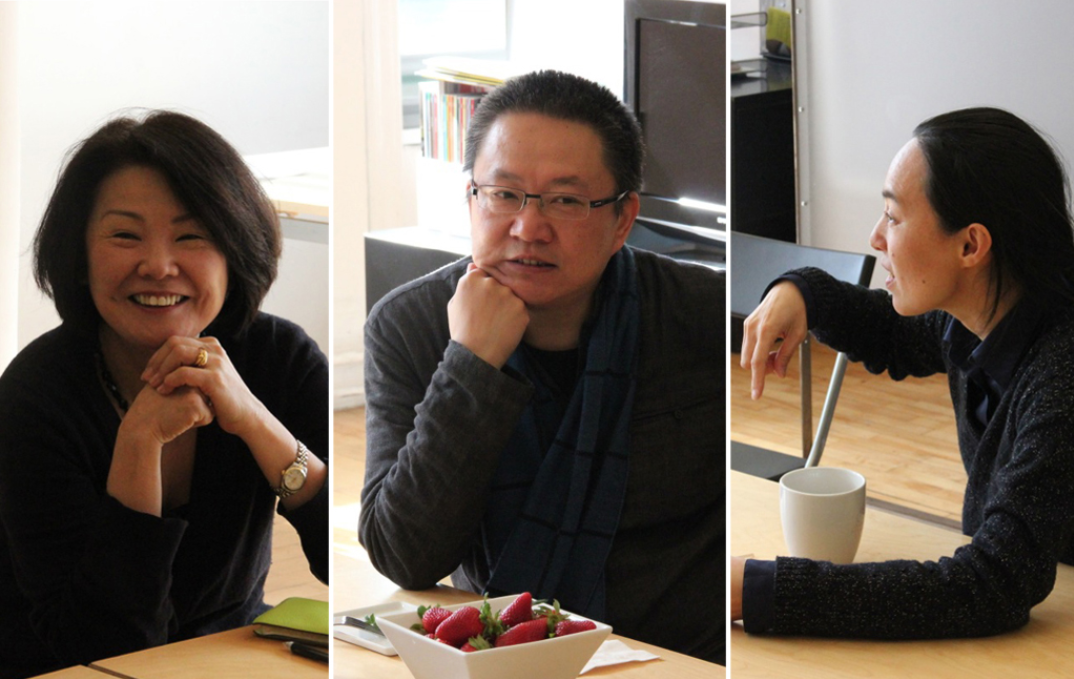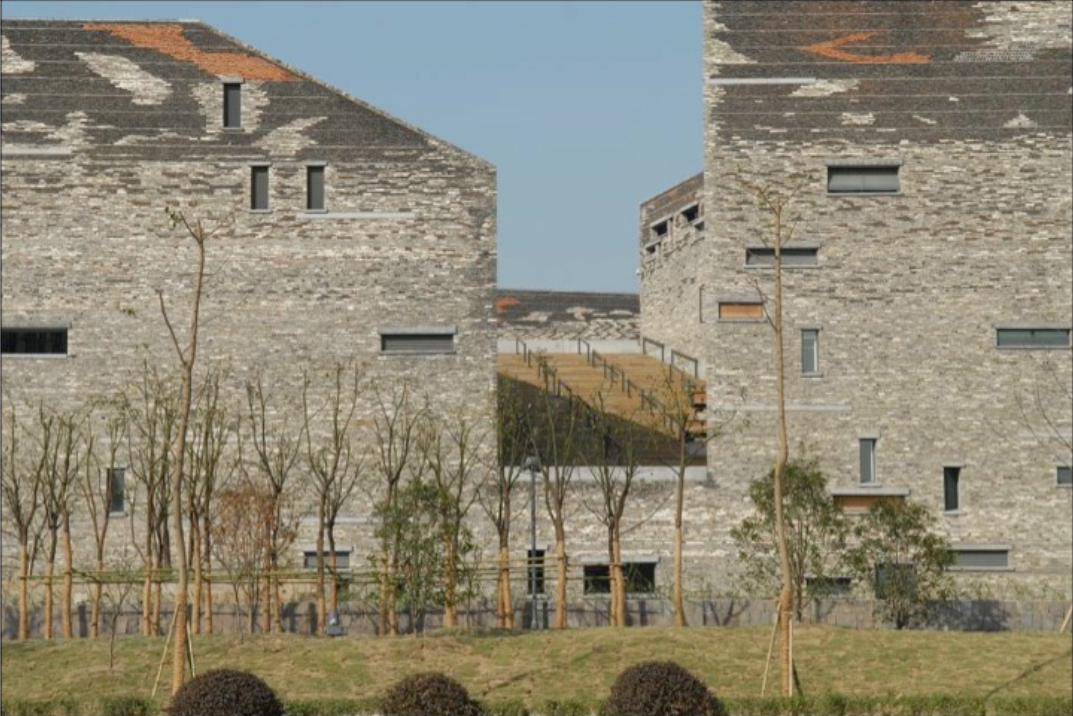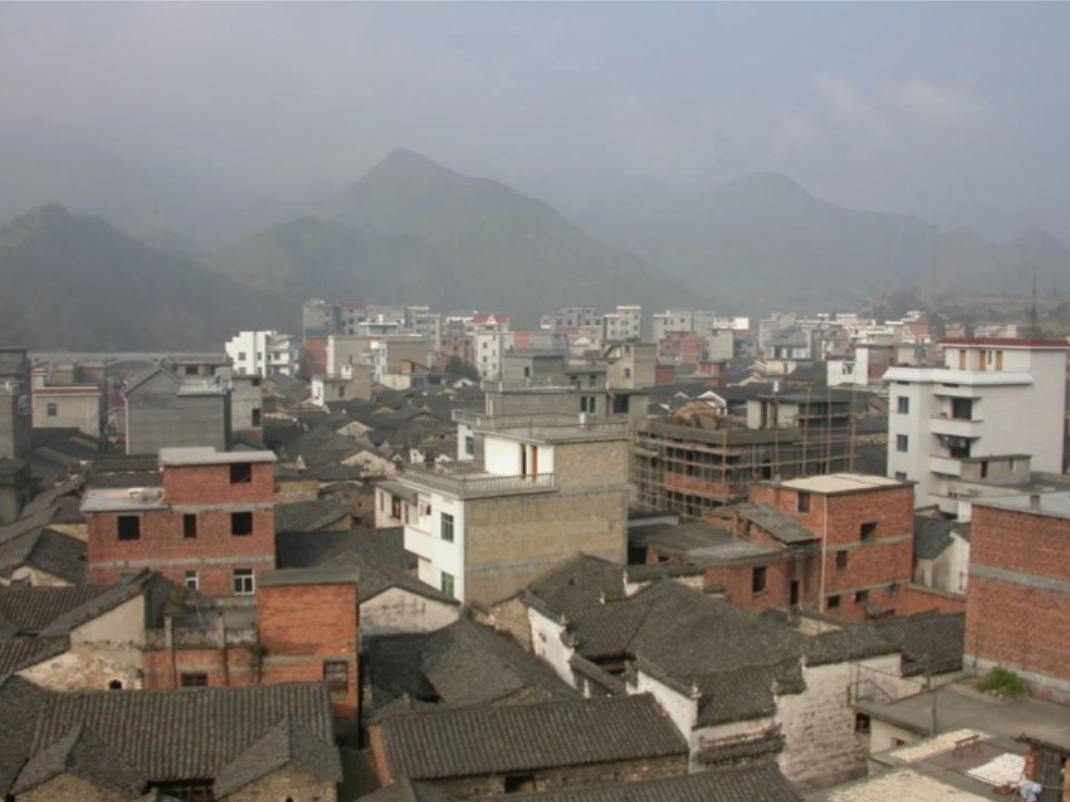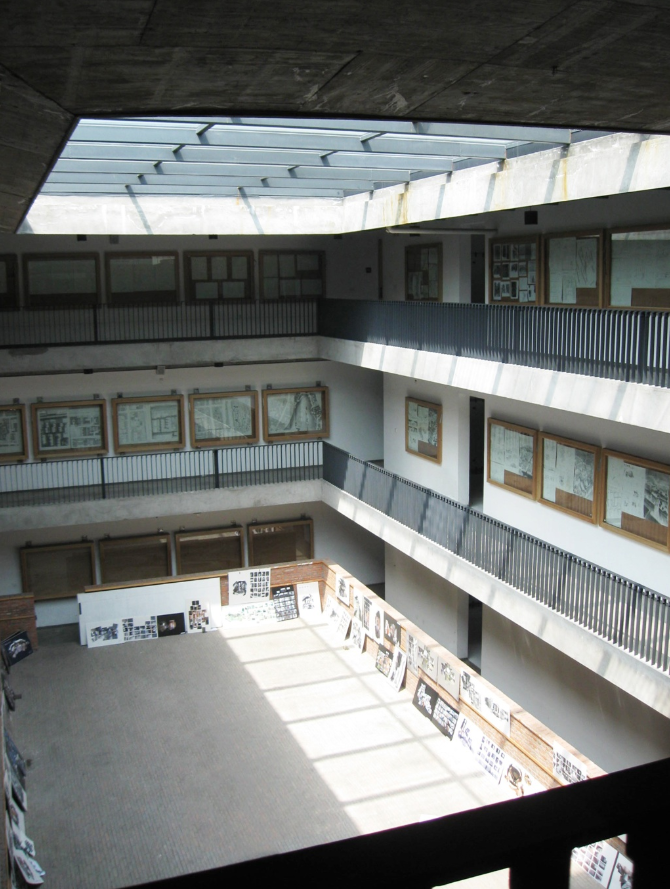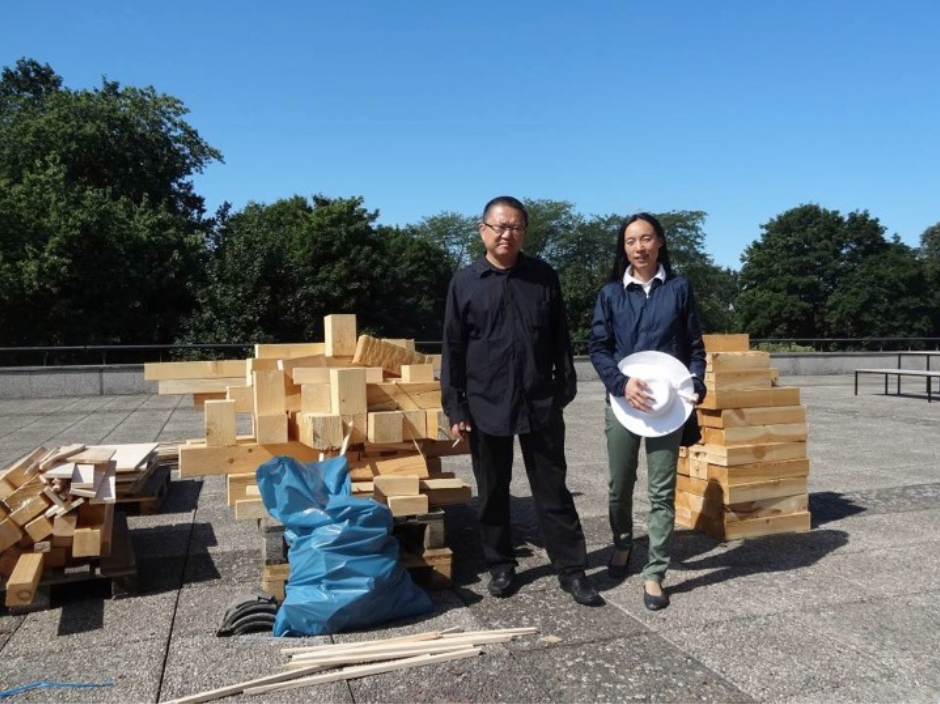On April 2, 2013, the day of his Current Work lecture at the Cooper Union, Wang Shu and his wife and partner Lu Wenyu sat down with Toshiko Mori at the League’s office to discuss their practice. Wang and Lu founded Amateur Architecture Studio together in 1997 in Hangzhou, China. The name of the office refers to the approach of an amateur builder—one based on spontaneity, craft skills, and cultural traditions. In order to learn traditional skills, Wang Shu spent the early part of his career working on building sites. Rather than looking toward the West for inspiration, the firm’s work is rooted firmly in the context of Chinese history and culture.
Toshiko Mori was introduced to Wang and Lu in 1994 by Ai Weiwei, and the friendship developed over project collaborations and at the Harvard Graduate School of Design, where Mori and Wang both taught studios in 2011. Mori, Wang, and Lu were joined in conversation by League Executive Director Rosalie Genevro and Program Director Anne Rieselbach. The following is an edited excerpt from that conversation.
I. PHILOSOPHY OF PRACTICE
Toshiko Mori: In your practice, Amateur Architects, there is a strong spirit of informality. Do you still work with that idea?
Wang Shu: It is always a dialectic between the formal and informal. We are most interested in that relationship. They have to coexist. I hate “perfect” things. To me, perfect things are just a lot of imperfect things put together. See this space? [He gestures to the room.] It’s a beautiful place, but you can see so many imperfect things. Right? Some people design too cleanly. They remove imperfections, everything disappearing perfectly into a line. It is perfect. But it’s not real life.
TM: It’s dead. It’s too sanitary, too over-controlled.
WS: I like a little bit of disorder. A little bit dirty and not so clean. That’s what we like.
TM: A kind of looseness, to give it life, or a place for it to enter your imagination, instead of a completely prescriptive formality.
WS: Yes, It introduces life.
TM: Your practice has resisted commercial construction activity in China—I mean the very big, fast projects, which are always exerting pressure. How do you resist that?
Lu Wenyu: It’s very difficult to do.
WS: I think the difficulty is not so much external as it is inside of you. The difficulty is to resist your need to accept the work. In China there are so many projects, many people will take on twenty new projects a year. As you become incredibly busy, you can no longer control the quality. We take maybe two projects a year, because we want to do interesting things, we want to do good work. It is not just about money.
TM: What do others think? Because, in China, there is always a power play. There are authorities, and people with money, and the government. There’s a lot of power, and you occupy a corner, which is a small, but very powerful area of resistance. How do you balance that—or do you avoid it altogether? I suppose one way is to avoid confrontation and do something very different. Another is to work with it, or confront it.
WS: It’s true that in China now many people are driven by money. But I think in the people’s hearts, they hope for something different. Secretly everybody hopes for a different way. And so, because our practice is doing things differently, we have found a respectful feeling toward our work. They understand our perspective.
LW: Sometimes it takes effort though. For example, with the Ningbo History Museum, initially the client—the Cultural Bureau—wanted to change our design. So after we had already won the local competition, they conducted a second, international competition.
WS: At first, I didn’t want to join this international competition. The second competition was for essentially the same site, just a little bit larger. We had an internal discussion and decided not to change the design. To just resubmit the old one to the new jury. We still won!
LW: I think at first the client was very angry about that. For a whole year they gave us a lot of trouble.
WS: But we kept working at it. I don’t think the client had ever met architects who worked so hard, so deeply. And finally they really accepted the work. They came to understand our perspective. Eventually they understood that during the construction process, our studio needed to have absolute control over the whole process.
LW: This respect is important because, in China, the client is very powerful. The construction company usually doesn’t believe in the architecture. They just believe in the client because they are the ones to pay them. So it is very difficult to do a project in China.
TM: I want to know more about the way you build. You started with the handmade, working with volunteers and students, but now you do much larger projects. How do you make that change without losing the spirit of handicraft?
LW: We do the first prototype ourselves in the office. But then we bring the construction workers in early on. We use a different construction company with every project; we do training with the workers in the studio.
TM: Your students and your staff are training the construction workers?
LW: Yes, together; it’s a collaboration.
TM: With your materials research and fabrication, your students can be instrumental in making buildings come together.
WS: Yes. This way, every work is a little bit different, but the process is the same.
LW: It’s a basic condition for working on the project. Every time the client and the construction company must agree to the collaborative methodology, otherwise we will refuse the project. It’s very important for us.
Anne Rieselbach: This is very interesting, because there are many Mexican architects—Jorge Gracia, for example—who are working in the same way, forming schools where workers and students all learn from each other.
LW: And the students are all very excited to do it. They learn how to do new projects, experiment with different materials. I think it’s very important.
WS: I am more focused on the workers; Wenyu is more focused on the students. She is also a professor of architecture, teaching a first-year course about traditional joinery and carpentry.
Rosalie Genevro: How did you learn these traditional techniques?
WS: We both learned from the working process. We have learned a great deal from the construction site. On many of our early projects, we would spend the whole day with the workers, learning every small step of the construction.
TM: Are you still able to find workers who have those skills in traditional crafts?
WS: If you are interested in traditional craft, you just have to go to the country, you will find it. The Cultural Revolution primarily affected the cities; much was preserved in the countryside. It’s still there.
TM: Do you find that younger people are interested in learning these traditional skills?
WS: The best craftsmen right now are mostly around 60 years old. That’s the last group. It’s a very dangerous situation. I think 10 years from now, maybe the majority of craftsmen will disappear. So we don’t have a lot of time if we want to do something. I have thought about starting another school for traditional craftsmanship.
TM: What are your roles on the construction site? Is the construction site a woman’s place in architecture in China?
LW: Yes. In China, the woman is very powerful.
WS: Really, more powerful than the man. The construction workers are more afraid of her.
LW: He’s very kind to the workers. Every worker likes him. They are afraid of me. The client, too!
WS: Yes, and I know that. If the client or craftsmen want to make something easier, but it means it won’t be right, they can’t say it to her. They say it to me. But I just say, “No, no, no. Everyone should listen to Lu. She’s the one in charge of this.” [Laughter]
TM: That’s a good strategy! In America we call it “Good Cop / Bad Cop.”
II. HANGZHOU AND THE CHINA ACADEMY OF ART
TM: You are practicing in Hangzhou, and your work is very related to this region. Tell me about the tradition of Hangzhou. Why did you decide to go to there?
WS: Hangzhou is sort of a dream town for the Chinese. You can find so many traditional poems about Hangzhou. It’s like an ideal city. In 1982, as a student, I had a trip to Hangzhou, and I spent some time on a small wooden boat on the lake in the middle of the city. Suddenly the weather changed, and it began raining. You could see the clouds move in over the mountains. It was an incredibly beautiful scene. That’s when I knew I would come here to live.
LW: It appears in many poems and literature, this lake. It is a destination for many Asian tourists because so many writers reference it.
WS: Yes. In fact, Hangzhou has a very close relationship to Japan. Tea is exported to Japan from Hangzhou. Also silk, and architecture. Buddhism spread to Japan from here. It’s also very near to Shanghai. But it has a totally different atmosphere. The people from Shanghai refer to Hangzhou as their backyard garden.
LW: It is really a triangle there: Shanghai, Hangzhou, and Nanjing.
WS: The region is known for its scholar’s culture. It is a cultural and intellectual capital, a capital for poetry and painting. Also politics. There is a tradition of artful seclusion here. I mean the scholars and critics, they are living in the countryside. They stay there and express their attitudes. The country life is better for this than the city life. We have very long and powerful history about this.
TM: Ai Weiwei has said that Hangzhou is the best architecture school and art school in China. Better than Beijing.
WS: I think so. In fact, when the architecture department was first opened in 2001, we only had two teachers. I was the only full time teacher. Ai Weiwei was teaching part time. So we were the two first teachers.
TM: You’ve been the dean since then…
LW: But it has been growing since then.
WS: We have 40 teachers now.
LW: And almost 600 students. 120 students applied for each spot this year. It has become very competitive.
TM: Why has the school attracted so many students do you think? Is it the pedagogy of the school that is popular? How is the philosophy of teaching different from other schools?
LW: The students often mix together and collaborate. And it is very hands-on environment. The students are learning very different skills, and sharing with one another.
WS: For example, in the first year the students receive calligraphy training. Our students have skills similar to artists. They’re not just about architecture.
LW: The architecture school is inside the art school. So we invite people from different departments to teach our students about calligraphy and drawing. To learn to work with the hand.
AR: It’s so great because so many students focus on digital design. We’ve lost touch with the hand.
WS: It’s different. The computer connects to your brain. But the hand, it connects to your heart and your body. The feeling is different.
LW: So we teach the students in the first year, how to work with real materials. Wood, brick, concrete, bamboo, metal. Real materials.
WS: We also make sure to have many interesting young teachers.
TM: They are all from China?
WS: About 20 or 30% come from somewhere else. Some as visitors, some stay for one or two years.
LW: Every year, we do some small workshops. For four or six weeks, early in the spring, foreign professors do workshop with our students. I think the professors from other countries like our students. We’ve been doing these workshops each year for six years now.
WS: Yes, but it is very new. The architecture department is the most popular at our school because it mixes architecture, urban design, and landscape together. This is our big experiment in the architecture department. We let the disciplines mix together like this.
III. PRITZKER PRIZE
TM: I just have one more question. Lu Wenyu, it’s very clear that you are a great collaborator with Wang Shu. You help set the pace of the architectural practice and you teach your students together. But the Pritzker Prize only formally recognizes Wang Shu.
WS: It’s not right.
TM: It’s not right. That needs to be corrected.
WS: Yes, of course. They should give the prize to us, and not to me.
TM: Or they should give a separate one to her alone.
WS: Yes, that’s better!
AR: You know, there’s a petition going around for Denise Scott Brown to get the prize retroactively, to go back and share it. Maybe we need to start a second petition.
RG: Now would be the perfect time to correct it.
TM: The two of them together. Students at the Harvard GSD started the petition. They got more than 2,000 signatures yesterday. [As of May 6, the petition has over 11,000 signatures. –Ed.] It’s nice that it came from female students. They have the momentum; it’s a good idea to do it.
RG: Also, the Pritzker Foundation said it would be difficult to give the prize to Denise Scott Brown retroactively because they have a different jury now than when they gave the prize to Venturi. But your award is very recent, so it could be possible.
Explore
Yung Ho Chang: Smallness
Excerpts from Chang's Current Work lecture, featuring public pavilions, a restaurant, and residential projects.
Sou Fujimoto: Between nature and architecture
The Japanese architect discusses three early conceptual works and six recent projects.
Zhang Ke lecture
The Beijing-based architect discusses a series of small-scale projects in China.

